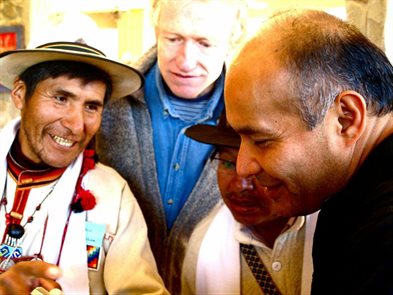Regarding the promotion and dissemination of cultural expressions, participants also observed that there are no concrete actions, related to authors or to the nation’s diverse cultural realities that allow Bolivians to become better informed about the country’s cultures.
Participants differentiated between two kinds of protection that are in force, even though in practice they are somewhat contradictory or confusing. One, linked to the National Intellectual Property Service ( SENAPI), tends to recognize the individual and the commercial dimension, and is backed by intellectual property law. The other, associated with the Ministry of Cultures, is related to the idea of registering and cataloguing heritage, and seeks ways of recognizing and respecting cultures.
 In Bolivia, conflicts have been generated when different groups claim as their own a broadly collective expression that is also recognized beyond the given community or region that makes the claim. In these cases, who enjoys the privileges attendant to that claim? Registration of cultural heritage has brought conflicts with it, and regulations could lead to injustice and omissions. Participants observed that there are still many problems internal to the power relations in which these processes are embedded. Mechanisms should be established to resolve these conflicts and the Ministry of Cultures should be in charge of internally working on reconciling these disputes, drawing on alternatives that emerge from civil society. For example, protocols may be proposed at the margins of existing judicial frameworks.
In Bolivia, conflicts have been generated when different groups claim as their own a broadly collective expression that is also recognized beyond the given community or region that makes the claim. In these cases, who enjoys the privileges attendant to that claim? Registration of cultural heritage has brought conflicts with it, and regulations could lead to injustice and omissions. Participants observed that there are still many problems internal to the power relations in which these processes are embedded. Mechanisms should be established to resolve these conflicts and the Ministry of Cultures should be in charge of internally working on reconciling these disputes, drawing on alternatives that emerge from civil society. For example, protocols may be proposed at the margins of existing judicial frameworks.
Research and history are crucial, not only to be faithful to the data and to avoid denying the existence of “ancient” expressions that should be respected and from which we still have so much to learn, but also not to restrict innovations. In this sense, cultural dissemination is important. Without it, culture is lost. Moreover, researchers cannot simply work independently, but rather different peoples need to be consulted about research conducted on their cultures.
Yet, this work is not only about conserving and registering cultural elements, but also about promoting on-going dynamic practices. Participants pointed out the need for all research to start by identifying cultural expressions by zones, areas, municipalities, and/or territories, to put in place specific protective strategies. In other words, this is about establishing concrete spaces of action. Moreover, every act of documentation could serve as evidence to avoid confusions, although it would be difficult and inappropriate to standardize cultural expressions through norms expected to work in the same way for all cases.
It is also important to understand that some things are not conceived of as eternal, as in the Western conception of art, but rather are seen as fleeting and/or temporary. Moreover, registration documentation should be able to account for any element that is part of a cultural context (ritual, symbolic, and historical dimensions, etc.). Every registration system should operate at this level of detail and complexity.
Today’s legislative proposals related to art and culture do not reflect coordinated and well-connected work among the appropriate and like-minded institutions. Information remains scattered among them.
Francisco Balboa, Henry Stobart, Celestino Campos and Iván Nogales - Photo credit: Phoebe Smolin